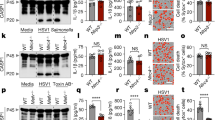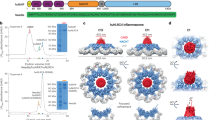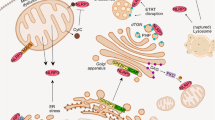Abstract
Phagocytosis is a fundamental cellular process that is pivotal for immunity as it coordinates microbial killing, innate immune activation and antigen presentation. An essential step in this process is phagosome acidification, which regulates many functions of these organelles that allow phagosomes to participate in processes that are essential to both innate and adaptive immunity. Here we report that acidification of phagosomes containing Gram-positive bacteria is regulated by the NLRP3 inflammasome and caspase-1. Active caspase-1 accumulates on phagosomes and acts locally to control the pH by modulating buffering by the NADPH oxidase NOX2. These data provide insight into a mechanism by which innate immune signals can modify cellular defenses and establish a new function for the NLRP3 inflammasome and caspase-1 in host defense.
This is a preview of subscription content, access via your institution
Access options
Subscribe to this journal
Receive 12 print issues and online access
$209.00 per year
only $17.42 per issue
Buy this article
- Purchase on Springer Link
- Instant access to full article PDF
Prices may be subject to local taxes which are calculated during checkout







Similar content being viewed by others
References
Greenberg, S. & Grinstein, S. Phagocytosis and innate immunity. Curr. Opin. Immunol. 14, 136–145 (2002).
Vieira, O.V., Botelho, R.J. & Grinstein, S. Phagosome maturation: aging gracefully. Biochem. J. 366, 689–704 (2002).
Desjardins, M., Huber, L.A., Parton, R.G. & Griffiths, G. Biogenesis of phagolysosomes proceeds through a sequential series of interactions with the endocytic apparatus. J. Cell Biol. 124, 677–688 (1994).
Scott, C.C., Botelho, R.J. & Grinstein, S. Phagosome maturation: a few bugs in the system. J. Membr. Biol. 193, 137–152 (2003).
Stuart, L.M. & Ezekowitz, R.A. Phagocytosis: elegant complexity. Immunity 22, 539–550 (2005).
Meresse, S. et al. Controlling the maturation of pathogen-containing vacuoles: a matter of life and death. Nat. Cell Biol. 1, E183–E188 (1999).
Wolf, A.J. et al. Phagosomal degradation increases TLR access to bacterial ligands and enhances macrophage sensitivity to bacteria. J. Immunol. 187, 6002–6010 (2011).
Amigorena, S. & Savina, A. Intracellular mechanisms of antigen cross presentation in dendritic cells. Curr. Opin. Immunol. 22, 109–117 (2010).
Lukacs, G.L., Rotstein, O.D. & Grinstein, S. Phagosomal acidification is mediated by a vacuolar-type H(+)-ATPase in murine macrophages. J. Biol. Chem. 265, 21099–21107 (1990).
Yates, R.M., Hermetter, A. & Russell, D.G. The kinetics of phagosome maturation as a function of phagosome/lysosome fusion and acquisition of hydrolytic activity. Traffic 6, 413–420 (2005).
Forgac, M. Vacuolar ATPases: rotary proton pumps in physiology and pathophysiology. Nat. Rev. Mol. Cell Biol. 8, 917–929 (2007).
Sun-Wada, G.H., Tabata, H., Kawamura, N., Aoyama, M. & Wada, Y. Direct recruitment of H+-ATPase from lysosomes for phagosomal acidification. J. Cell Sci. 122, 2504–2513 (2009).
Brisseau, G.F. et al. Interleukin-1 increases vacuolar-type H+-ATPase activity in murine peritoneal macrophages. J. Biol. Chem. 271, 2005–2011 (1996).
Trombetta, E.S., Ebersold, M., Garrett, W., Pypaert, M. & Mellman, I. Activation of lysosomal function during dendritic cell maturation. Science 299, 1400–1403 (2003).
Savina, A. et al. NOX2 controls phagosomal pH to regulate antigen processing during crosspresentation by dendritic cells. Cell 126, 205–218 (2006).
Underhill, D.M. et al. The Toll-like receptor 2 is recruited to macrophage phagosomes and discriminates between pathogens. Nature 401, 811–815 (1999).
Ozinsky, A. et al. The repertoire for pattern recognition of pathogens by the innate immune system is defined by cooperation between toll-like receptors. Proc. Natl. Acad. Sci. USA 97, 13766–13771 (2000).
Underhill, D.M. & Gantner, B. Integration of Toll-like receptor and phagocytic signaling for tailored immunity. Microbes Infect. 6, 1368–1373 (2004).
Blander, J.M. & Medzhitov, R. Regulation of phagosome maturation by signals from toll-like receptors. Science 304, 1014–1018 (2004).
Yates, R.M. & Russell, D.G. Phagosome maturation proceeds independently of stimulation of toll-like receptors 2 and 4. Immunity 23, 409–417 (2005).
Shimada, T. et al. Staphylococcus aureus evades lysozyme-based peptidoglycan digestion that links phagocytosis, inflammasome activation, and IL-1beta secretion. Cell Host Microbe 7, 38–49 (2010).
Grabarek, J. & Darzynkiewicz, Z. In situ activation of caspases and serine proteases during apoptosis detected by affinity labeling their enzyme active centers with fluorochrome-tagged inhibitors. Exp. Hematol. 30, 982–989 (2002).
Hackam, D.J. et al. Regulation of phagosomal acidification. Differential targeting of Na+/H+ exchangers, Na+/K+-ATPases, and vacuolar-type H+-atpases. J. Biol. Chem. 272, 29810–29820 (1997).
Lukacs, G.L., Rotstein, O.D. & Grinstein, S. Determinants of the phagosomal pH in macrophages. In situ assessment of vacuolar H(+)-ATPase activity, counterion conductance, and H+ “leak. J. Biol. Chem. 266, 24540–24548 (1991).
Steinberg, B.E., Huynh, K.K. & Grinstein, S. Phagosomal acidification: measurement, manipulation and functional consequences. Biochem. Soc. Trans. 35, 1083–1087 (2007).
Trost, M. et al. The phagosomal proteome in interferon-gamma-activated macrophages. Immunity 30, 143–154 (2009).
Zhang, B., Zhang, Y. & Shacter, E. Caspase 3–mediated inactivation of rac GTPases promotes drug-induced apoptosis in human lymphoma cells. Mol. Cell Biol. 23, 5716–5725 (2003).
Shao, W., Yeretssian, G., Doiron, K., Hussain, S.N. & Saleh, M. The caspase-1 digestome identifies the glycolysis pathway as a target during infection and septic shock. J. Biol. Chem. 282, 36321–36329 (2007).
Baniulis, D. et al. Evaluation of two anti-gp91phox antibodies as immunoprobes for Nox family proteins: mAb 54.1 recognizes recombinant full-length Nox2, Nox3 and the C-terminal domains of Nox1–4 and cross-reacts with GRP 58. Biochim. Biophys. Acta 1752, 186–196 (2005).
Foubert, T.R. et al. Identification of a spectrally stable proteolytic fragment of human neutrophil flavocytochrome b composed of the NH2-terminal regions of gp91(phox) and p22(phox). J. Biol. Chem. 276, 38852–38861 (2001).
Burritt, J.B., Quinn, M.T., Jutila, M.A., Bond, C.W. & Jesaitis, A.J. Topological mapping of neutrophil cytochrome b epitopes with phage-display libraries. J. Biol. Chem. 270, 16974–16980 (1995).
Ip, W.K. et al. Phagocytosis and phagosome acidification are required for pathogen processing and MyD88-dependent responses to Staphylococcus aureus. J. Immunol. 184, 7071–7081 (2010).
Mantegazza, A.R. et al. NADPH oxidase controls phagosomal pH and antigen cross-presentation in human dendritic cells. Blood 112, 4712–4722 (2008).
Keller, M., Ruegg, A., Werner, S. & Beer, H.D. Active caspase-1 is a regulator of unconventional protein secretion. Cell 132, 818–831 (2008).
Gurcel, L., Abrami, L., Girardin, S., Tschopp, J. & van der Goot, F.G. Caspase-1 activation of lipid metabolic pathways in response to bacterial pore-forming toxins promotes cell survival. Cell 126, 1135–1145 (2006).
Master, S.S. et al. Mycobacterium tuberculosis prevents inflammasome activation. Cell Host Microbe 3, 224–232 (2008).
Akhter, A. et al. Caspase-7 activation by the Nlrc4/Ipaf inflammasome restricts Legionella pneumophila infection. PLoS Pathog. 5, e1000361 (2009).
Amer, A. et al. Regulation of Legionella phagosome maturation and infection through flagellin and host Ipaf. J. Biol. Chem. 281, 35217–35223 (2006).
Fernandes-Alnemri, T. et al. The pyroptosome: a supramolecular assembly of ASC dimers mediating inflammatory cell death via caspase-1 activation. Cell Death Differ. 14, 1590–1604 (2007).
Lamkanfi, M. & Dixit, V.M. The inflammasomes. PLoS Pathog. 5, e1000510 (2009).
Herskovits, A.A., Auerbuch, V. & Portnoy, D.A. Bacterial ligands generated in a phagosome are targets of the cytosolic innate immune system. PLoS Pathog. 3, e51 (2007).
Park, B. et al. Proteolytic cleavage in an endolysosomal compartment is required for activation of Toll-like receptor 9. Nat. Immunol. 9, 1407–1414 (2008).
Ewald, S.E. et al. The ectodomain of Toll-like receptor 9 is cleaved to generate a functional receptor. Nature 456, 658–662 (2008).
Mahrus, S. et al. Global sequencing of proteolytic cleavage sites in apoptosis by specific labeling of protein N termini. Cell 134, 866–876 (2008).
Meissner, F. et al. Inflammasome activation in NADPH oxidase defective mononuclear phagocytes from patients with chronic granulomatous disease. Blood 116, 1570–1573 (2010).
Zhou, R., Yazdi, A.S., Menu, P. & Tschopp, J. A role for mitochondria in NLRP3 inflammasome activation. Nature 469, 221–225 (2011).
Akhter, A. et al. Caspase-11 promotes the fusion of phagosomes harboring pathogenic bacteria with lysosomes by modulating actin polymerization. Immunity 37, 35–47 (2012).
Taxman, D.J., Huang, M.T. & Ting, J.P. Inflammasome inhibition as a pathogenic stealth mechanism. Cell Host Microbe 8, 7–11 (2010).
Sokolovska, A., Becker, C.E. & Stuart, L.M. Measurement of phagocytosis, phagosome acidification, and intracellular killing of Staphylococcus aureus. Curr. Protoc. Immunol. Unit14 30 (2012).
Halle, A. et al. The NALP3 inflammasome is involved in the innate immune response to amyloid-beta. Nat. Immunol. 9, 857–865 (2008).
Hornung, V. et al. Silica crystals and aluminum salts activate the NALP3 inflammasome through phagosomal destabilization. Nat. Immunol. 9, 847–856 (2008).
Kasperkovitz, P.V., Cardenas, M.L. & Vyas, J.M. TLR9 is actively recruited to Aspergillus fumigatus phagosomes and requires the N-terminal proteolytic cleavage domain for proper intracellular trafficking. J. Immunol. 185, 7614–7622 (2010).
Savina, A., Vargas, P., Guermonprez, P., Lennon, A.M. & Amigorena, S. Measuring pH, ROS production, maturation, and degradation in dendritic cell phagosomes using cytofluorometry-based assays. Methods Mol. Biol. 595, 383–402 (2010).
Ramachandra, L., Boom, W.H. & Harding, C.V. Class II MHC antigen processing in phagosomes. Methods Mol. Biol. 445, 353–377 (2008).
Miggin, S.M. et al. NF-kappaB activation by the Toll-IL-1 receptor domain protein MyD88 adapter-like is regulated by caspase-1. Proc. Natl. Acad. Sci. USA 104, 3372–3377 (2007).
Acknowledgements
This work was funded by grants from US National Institutes of Health National Institute of Allergy and Infectious Diseases to L.M.S. (RO1 AI079198) and K.A.F. (RO1 AI093752), National Institutes of Health National Institute on Aging to K.J.M. (RO1 AG020255), grants from the Crohns' and Colitis and Hood foundations and National Institutes of Health National Institute of Diabetes and Digestive and Kidney Diseases to A.L.-H. (RO1 DK093695), and postdoctoral fellowships from Massachusetts General Hospital Executive Committee on Research to A.S. and New England Regional Center of Excellence–Biodefense and Emerging Infectious Diseases (U54 AI057159 to N.P.). Electron microscopy was performed by M. McKee in the Microscopy Core of the Center for Systems Biology.
Author information
Authors and Affiliations
Contributions
A.S., C.E.B. and W.K.E.I. designed, analyzed and performed experiments. V.A.K.R., M.B., N.P., A.T. and S.K.V. contributed to experimental design, provided discussions and assisted with experiments. K.J.M., K.A.F. and A.L.-H. contributed to data analysis, discussions and manuscript preparation. L.M.S. designed and analyzed experiments, supervised the project and prepared the manuscript with A.S. and C.E.B.
Corresponding authors
Ethics declarations
Competing interests
The authors declare no competing financial interests.
Supplementary information
Supplementary Text and Figures
Supplementary Figures 1–7 (PDF 1097 kb)
Supplementary Table 1
List of potential phagosome-associated caspase-1 substrates. Potential caspase-1 cleavage sites in all the phagosome-associated proteins identified in ref. 26 were determined by the SitePrediction algorithm (sheet 1; http://www.dmbr.ugent.be/prx/bioit2-public/SitePrediction/). Data were filtered at 99% confidence. Potential phagosome caspase-1 substrates identified by SitePrediction were further classified by DAVID analysis to identify enriched gene functions (sheet 2). (XLS 87 kb)
Rights and permissions
About this article
Cite this article
Sokolovska, A., Becker, C., Ip, W. et al. Activation of caspase-1 by the NLRP3 inflammasome regulates the NADPH oxidase NOX2 to control phagosome function. Nat Immunol 14, 543–553 (2013). https://doi.org/10.1038/ni.2595
Received:
Accepted:
Published:
Issue Date:
DOI: https://doi.org/10.1038/ni.2595
This article is cited by
-
Interplay of gene expression and regulators under salinity stress in gill of Labeo rohita
BMC Genomics (2023)
-
Pratensein Mitigates Oxidative Stress and NLRP3 Inflammasome Activation in OGD/R-Injured HT22 Cells by Activating Nrf2-Anti-oxidant Signaling
Neurotoxicity Research (2022)
-
Insights into inflammasome regulation: cellular, molecular, and pathogenic control of inflammasome activation
Immunologic Research (2022)
-
Neutrophil extracellular trap clearance by synovial macrophages in gout
Arthritis Research & Therapy (2021)
-
Macrophage mediated recognition and clearance of Borrelia burgdorferi elicits MyD88-dependent and -independent phagosomal signals that contribute to phagocytosis and inflammation
BMC Immunology (2021)



